Micropetrography as a Key Preliminary Tool for Addressing Provenance Issues: Insights from a Roman Istria Case Study (Croatia)
Abstract
1. Introduction

| No. | Name | Ager | Bibliography | Geological Age |
|---|---|---|---|---|
| 1 | Oprtalj—Sv. Stjepan | Tergeste | [21] | Cenomanian |
| 2 | Tar-Vabriga—Tarska vala | Parentium | [12,13,21] | Albian |
| 3 | Tar-Vabriga | Parentium | [12,13] | Albian |
| 4 | Poreč—Sv. Nikola | Parentium | [12,13] | Late Tithonian? |
| 5 | Poreč—Naftaplin | Parentium | [21,22] | Oxfordian–Kimmeridgian |
| 6 | Poreč—Sv. Anđeo | Parentium | [21,22] | Oxfordian–Kimmeridgian? |
| 7 | Vrsar—Sv. Juraj | Parentium | [12,13] | Oxfordian–Kimmeridgian |
| 8 | Vrsar | Parentium | [12,13,21] | Late Tithonian |
| 9 | Vrsar—Vankanela | Parentium | [21] | Oxfordian–Kimmeridgian |
| 10 | Vrsar—Monte Ricco | Parentium | [12,13,21] | Oxfordian–Kimmeridgian |
| 11 | Vrsar—Biškupovi vrhi (Monte del Vescovo) | Parentium | [21] | Oxfordian–Kimmeridgian |
| 12 | Vrsar—Biškupovi vrhi 2 (Monte del Vescovo 2) | Parentium | [21] | Oxfordian–Kimmeridgian |
| 13 | Vrsar—Flengi Smokovac | Parentium | [21] | Oxfordian–Kimmeridgian |
| 14 | Vrsar—Flengi Vršćić | Parentium | [21] | Oxfordian–Kimmeridgian |
| 15 | Vrsar—Flengi | Parentium | [21] | Oxfordian–Kimmeridgian |
| 16 | Vrsar—Prekijov vrh 3 | Parentium | [21] | Oxfordian–Kimmeridgian |
| 17 | Vrsar—Prekijov vrh 2 | Parentium | [21] | Oxfordian–Kimmeridgian |
| 18 | Vrsar—Prekijov vrh 1 | Parentium | [21] | Oxfordian–Kimmeridgian |
| 19 | Vrsar—Delići Kontija 1 | Parentium | [21] | Oxfordian–Kimmeridgian |
| 20 | Vrsar—Delići Kontija 2 | Parentium | [21] | Oxfordian–Kimmeridgian |
| 21 | Vrsar—Kloštar | Parentium | [21] | Early Berriasian |
| 22 | Rovinj—Majorov vrh | Pola | [23] | Oxfordian–Kimmeridgian |
| 23 | Rovinj—Uvala Soline | Pola | [12,13,24] | Oxfordian–Kimmeridgian |
| 24 | Rovinj—Uvala Križ (Faborso) | Pola | [12,13] | Oxfordian–Kimmeridgian |
| 25 | Rovinj—Zlatni rt (Montauro) | Pola | [12,13,21] | Late Tithonian |
| 26 | Rovinj—Monte delle Arni | Pola | [12,13] | Late Berriasian–Early Valangian |
| 27 | Rovinj—Rt Damjan | Pola | [12,13,21] | Hauterivian |
| 28 | Bale—Skačota | Pola | [12,13,25] | Hauterivian |
| 29 | Rakalj | Pola | [21,26,27] | Turonian–Campanian |
| 30 | Marčana—Pločevi Dvori | Pola | [12,13,21] | Cenomanian |
| 31 | Brijuni—Kamenolom u uvali Madona | Pola | [28] | Barremian |
| 32 | Brijuni—Kamenolom Zoo | Pola | [28] | Barremian |
| 33 | Brijuni—Kochov kamenolom | Pola | [28] | Barremian |
| 34 | Brijuni—Čufarov kamenolom | Pola | [28] | Barremian |
| 35 | Brijuni—Kamenolom pod Gradinom | Pola | [28] | Aptian |
| 36 | Pula—Šandalja | Pola | [12,13] | Cenomanian |
| 37 | Pula—Pješčana Uvala | Pola | [21] | Cenomanian |
| 38 | Pula—Vinkuran (Cave Romane) | Pola | [12,13,21,24,29] | Cenomanian |
| 39 | Medulin—Pećinice | Pola | [12,13] | Cenomanian |
| 40 | Pula—Uvala Soline 1 | Pola | [21] | Cenomanian |
| 41 | Pula—Uvala Soline 2 | Pola | [21] | Cenomanian |
| 42 | Pula—Uvala Soline 3 | Pola | [21] | Cenomanian |
| 43 | Banjole | Pola | [12,13] | Cenomanian |
| 44 | Frašker | Pola | [21] | Early Cretaceous |
| 45 | Medulin—Premanturski školjić | Pola | [12,21] | Late Cretaceous? |
| 46 | Medulin—Vižula | Pola | [12,13] | Late Cenomanian-Early Turonian |
| 47 | Premantura—Rt Mugli | Pola | [21] | Cenomanian |
| 48 | Premantura—Otočić Šekovac | Pola | [21] | Turonian–Campanian |
| 49 | Premantura—Uvala Portić (Porto Rosso) | Pola | [12,13] | Turonian–Campanian |
2. Materials and Methods
- (1)
- Documentation of ancient quarries in the selected area, with information on geological age and type of deposits.
- (2)
- Selection of Roman monuments and findings for analysis, depending on availability.
- (3)
- Establishment of a hypothesis on the origin of stone for their production.
- (4)
- Sampling archaeological sites and quarries.
- (5)
- Mineralogical–petrographic analysis, determination of rock type, microfacies, characteristic microfossils (when possible), determination of age, sample comparison.
- (6)
- Interpretation and conclusions.
3. Micropetrographic Analysis of Archaeological Finds
3.1. Parentium Ager
3.2. Ager Polensis
4. Sampled Roman Quarries
4.1. Monte Ricco Quarry
4.2. Poreč (Naftaplin) Quarry
4.3. Biškupovi Vrhi (Monte Del Vescovo) Quarry
4.4. Pješčana Uvala Quarry
4.5. Cave Romane (Vinkuran)
4.6. Marčana
5. Connectedness, Transport and Profitability Analysis
6. Results and Discussion
7. Conclusions
Funding
Data Availability Statement
Acknowledgments
Conflicts of Interest
References
- Vlahović, I.; Velić, I.; Dubravko, M. A brief introduction to the geology of Istria. In Proceedings of the 7th Croatian Geological Congress with International Participation Excursion Guide-Book, Poreč, Croatia, 2–4 October 2023; Fio Firi, K., Čobić, A., Eds.; Hrvatski Geološki Institut: Poreč, Croatia, 2023; pp. 1–13. [Google Scholar]
- Vlahović, I.; Tišljar, J.; Velić, I.; Dubravko, M. Evolution of the Adriatic Carbonate Platform: Paleogeography, main events and depositional dynamics. Palaeogeogr. Palaeoclimatol. Palaeoecol. 2005, 220, 333–360. [Google Scholar] [CrossRef]
- Tišljar, J. Sedimentologija Karbonata i Evaporita; Institut za Geološka Istraživanja: Zagreb, Croatia, 2001. [Google Scholar]
- Gabrovec, S.; Mihovilić, K. Istarska grupa. In Praistorija Jugoslavenskih Zemalja V; Gabrovec, S., Ed.; Akademija Nauka i Umjetnosti Bosne i Hercegovine: Sarajevo, Bosnia and Herzegovina, 1987; pp. 293–338. [Google Scholar]
- Codacci-Terlević, G. Prilog poznavanju brončanodobnih pogrebnih običaja u Istri–Stanje istraženosti istarskih tumula te rezultati istraživanja tumula iz uvale Marić kod Barbarige. Histria Archaeol. 2004, 35, 41–74. [Google Scholar]
- Hänsel, B.; Kristina, M.; Monkodonja, B.T. Utvrđeno protourbano naselje starijeg i srednjeg brončanog doba kod Rovinja u Istri. Histria Archaeol. 1997, 28, 37–107. [Google Scholar]
- Buršić-Matijašić, K. Gradinska Naselja. Gradine Istre u Vremenu i Prostoru; Leykam International: Zagreb, Croatia, 2008. [Google Scholar]
- Hänsel, B.; Mihovilić, K.; Biba, T. Monkodonja. Istraživanje Protourbanog Naselja Brončanog Doba Istre. Knjiga 1. Iskopavanje i Nalazi Građevina; Monografije i Katalozi 25, Arheološki muzej Istre: Pula, Croatia, 2015. [Google Scholar]
- Matijašić, R. Romanizaton of the Histri in the Early Roman Period. In Illyrica Antiqua in Honorem Duje Rendić-Miočević, Proceedings of the Internatonal Conference, Šibenik, 12–15 September 2013; Demicheli, D., Ed.; Department of Archaeology, Faculty of Humanities and Social Sciences, University of Zagreb: Zagreb, Croatia, 2017; pp. 379–390. [Google Scholar]
- Parica, M. Arheološki Tragovi Kamenarstva u Dalmaciji od Prapovijesti do Kraja Srednjeg Vijeka (Archaeological Evidence of Stone Quarrying in Dalmatia from Prehistory to the End of the Middle Ages). Ph.D. Thesis, University of Zagreb, Zagreb, Croatia, 2014. (Summary in English). [Google Scholar]
- Crnković, B. The Origin of the Dimension Stone of the Arena in Pula. Rud.-Geološko-Naft. Zb. 1991, 3, 63–67. [Google Scholar]
- Matijašić, R. Gospodarstvo antičke Istre; Zavičajna Naklada “Žakan Juri” Pula: Pula, Croatia, 1998. [Google Scholar]
- Šonje, A. Iz kojeg istarskog kamena potječe kupola Teodorikova mauzoleja u Ravenni. In Materijali, Tehnike i Strukture; Suić, M., Zaninović, M., Eds.; Odjel za Arheologiju, Centar za Povijesne Znanosti: Zagreb, Croatia, 1980; pp. 149–160. [Google Scholar]
- Pleničar, M.; Polšak, A.; Dragutin, Š. Osnovna Geološka Karta SFRJ M 1:100 000, List Trst L 33-88; Geološki Zavod Ljubljana: Ljubljana, Slovenia; Inštitut za Geološka Istraživanja Zagreb: Zagreb, Croatia; Savezni Geološki Institut Beograd: Beograd, Serbia, 1969. [Google Scholar]
- Šikić, D.; Polšak, A.; Nikola, M. Osnovna Geološka Karta SFRJ M 1:100 000, List Labin L 33-101; Inštitut za Geološka Istraživanja Zagreb: Zagreb, Croatia; Savezni Geološki Institut Beograd: Beograd, Serbia, 1969. [Google Scholar]
- Šikić, D.; Pleničar, M.; Marko, Š. Osnovna Geološka Karta SFRJ M 1:100 000, List Ilirska Bistrica L 33-89; Inštitut za Geološka Istraživanja Zagreb: Zagreb, Croatia; Savezni Geološki Institut Beograd: Beograd, Serbia, 1972. [Google Scholar]
- Polšak, A.; Dragutin, Š. Osnovna Geološka Karta SFRJ M 1:100 000, List Rovinj L 33-100; Inštitut za Geološka Istraživanja Zagreb: Zagreb, Croatia; Savezni Geološki Institut Beograd: Beograd, Serbia, 1969. [Google Scholar]
- Polšak, A. Osnovna Geološka Karta SFRJ M 1:100 000, List Pula L 33-112; Inštitut za Geološka Istraživanja Zagreb: Zagreb, Croatia; Savezni Geološki Institut Beograd: Beograd, Serbia, 1967. [Google Scholar]
- Magaš, N. Osnovna Geološka Karta SFRJ M 1:100 000, List Cres L 33-113; Institut za Geološka Istraživanja Zagreb: Zagreb, Croatia; Savezni Geološki Zavod Beograd: Beograd, Serbia, 1968. [Google Scholar]
- Miko, S.; Kruk, B.; Dedić, Ž.; Kruk, L.; Peh, Z.; Kovačević-Galović, E.; Anto, G. Rudarsko-Geološka Studija Potencijala i Gospodarenja Mineralnim Sirovinama Istarske Županije; Hrvatski Geološki Institute: Zagreb, Croatia, 2013. [Google Scholar]
- Šprem, K. Eksploatacija Kamene Sirovine u Prapovijesti i Antici Istarskoga Poluotoka (Exploitation of Stone Raw Material in Prehistory and Antiquity in the Istrian Peninsula). Ph.D. Thesis, University of Zagreb, Zagreb, Croatia, 30 September 2022. (Summary in English). [Google Scholar]
- Benčić, G. Note sulla lavorazione ed esportazione della pietra d’Istria nel medioevo. In Artisani et Mercatores: Artisans and merchants in the Adriatic Sea; Crljenko, M.M., Uljančić, E., Eds.; Državni Arhiv u Pazinu: Pazin, Croatia; Zavičajni Muzej Poreštine: Poreč, Croatia; Sveučilište Jurja Dobrile u Puli: Pula, Croatia, 2019; pp. 100–117. [Google Scholar]
- Paić, A. Sondažno arheološko istraživanje na lokalitetima Monmaggior i Mon dei Arni u sklopu TZ Valalta u Rovinju. 2024. [Google Scholar]
- Mlakar, Š. Amfiteatar u Puli; Arheološki muzej Istre u Puli: Pula, Croatia, 1996. [Google Scholar]
- Buršić-Matijašić, K.; Robert, M. The Extraction and Use of Limestone in Istria in Antiquity. In ASMOSIA XI Proceedings of the XI ASMOSIA Conference; Matetić Poljak, D., Marasović, K., Eds.; University of Split, Arts Academy in Split: Split, Croatia, 2018; pp. 925–931. [Google Scholar]
- Girardi-Jurkić, V. Korištenje kamena u gradnji amfiteatra u Puli. Histria Antiq. 1997, 3, 21–28. [Google Scholar]
- Zlatunić, R. Povijest i razvoj tehnologije vađenja kamena i kamenoklesarstva. In Tragovima Kamenoklesara; Starac, A., Ed.; Arheološki Muzej Istre u Puli: Pula, Croatia, 2006; pp. 185–206. [Google Scholar]
- Premužić Ančić, M.; Sanja, G. Quarries on the island Veliki Brijun, The Beginnings of their rehabilitation and adaptive reuse in Croatia. A Sch. J. Archit. Urban Plan. 2017, 25, 74–85. [Google Scholar]
- Girardi-Jurkić, V. The Cavae Romanae quarry. Properties and use of the stone for the amphitheatre in Pula. In Interdisciplinary Studies on Ancient Stone. Proceedings of the IX ASMOSIA Conference; Garcia-M., A.G., Mercadal, P.L., de Llanza, I.R., Eds.; Institut Català d’Arqueologia Clàssica: Tarragona, Spain, 2012; pp. 640–644. [Google Scholar]
- Dunham, R.J. Classification of carbonate rocks according to depositional texture. In Classification of Carbonate Rocks, AAPG Memoir 1; Ham, W.E., Ed.; American Association of Petroleum Geologists: Tulsa, OK, USA, 1962; pp. 108–121. [Google Scholar]
- Embry, A.F.; Edward Klovan, J. A late Devonian Reef tract on Northeastern Banks Island, N.W.T. Bull. Can. Pet. Geol. 1971, 19, 730–781. [Google Scholar]
- Folk, R.L. Spectral Subdivision of limestone types. In Classification of Carbonate Rocks, AAPG Memoir 1; Ham, W.E., Ed.; American Association of Petroleum Geologists: Tulsa, OK, USA, 1962; pp. 62–84. [Google Scholar]
- Bulić, D. Izvješće o Arheološkom Istraživanju na Lokalitetu Monte Ricco Kraj Vrsara u Lipnju 2020; Godine: Boston, MA, USA, 2020. [Google Scholar]
- Bulić, D. Izvješće o Arheološkom Istraživanju na Lokalitetu Monte Ricco Kraj Vrsara 2020; Godine: Boston, MA, USA, 2020. [Google Scholar]
- Bulić, D. Izvješće Arheološkog Istraživanja Antičke Cisterne na Lokalitetu Monte Ricco 2018; Godine: Boston, MA, USA, 2018. [Google Scholar]
- Bulić, D. Izvješće o Arheološkom Istraživanju na Lokalitetu Monte Ricco Kraj Vrsara 2019; Godine: Boston, MA, USA, 2019. [Google Scholar]
- Buršić-Matijašić, K.; Matijašić, R. Projekt RAT-ROPH i arheološko istraživanje u Vrsaru 2014. i 2015. Godine. Obavijesti Hrvat. Arheol. Društva God 2016, XLVIII, 17–26. [Google Scholar]
- Cvetko Tešović, B.; Glumac, B.; Damir, B. Integrated biostratigraphy and carbon isotope stratigraphy of the Lower Cretaceous (Barremian to Albian) Adriatic-Dinaridic carbonate platform deposits in Istria, Croatia. Cretac. Res. 2011, 32, 301–324. [Google Scholar] [CrossRef]
- Velić, I. Stratigraphy and Palaebiogeography of Mesozoic Benthic Foraminifera of the Karst Dinarides (SE Europe). Geol. Croat. 2007, 60, 1–113. [Google Scholar] [CrossRef]
- Epigraphic Database Roma. Available online: http://www.edr-edr.it/default/index.php (accessed on 24 November 2024).
- Schlagintweit, F.; Bover-Arnal, T.; Ramon, S. New insights into Lithocodium aggregatum Elliott (1956) and Bacinella irregularis Radoičić (1959) (Late Jurassic–Lower Cretaceous): Two ulvophycean green algae (? Order Ulotrichales) with a heteromorphic life cycle (epilithic/euendolithic). Facies 2010, 56, 509–547. [Google Scholar] [CrossRef]
- Buršić-Matijašić, K. (Ed.) Monte Ricco Kraj Vrsara. Rimskodobne Preobrazbe I Ponovna Uporaba Prapovijesnih Gradina Istre; CIRLA Monografije, Svezak 1, Sveučilište Jurja Dobrile u Puli i Općina Vrsar: Pula, Croatia, 2020. [Google Scholar]
- Cotman, I. Istraživanje arhitektonsko-građevnog kamen. In Kamen Pazin 1954–2004; Josip, B., Ivan, C., Eds.; “KAMEN” d. d.: Pazin, Croatia, 2004; pp. 80–101. [Google Scholar]
- Tišljar, J. Sedimentne Stijene; Školska Knjiga: Zagreb, Croatia, 1994. [Google Scholar]
- Šprem, K. What to expect when you’re documenting and excavating a Roman quarry–Monte del Vescovo, Istria, Croatia. In From Quarries to Rock-Cut Sites. Echoes of Stone Crafting; Anais, L., Katy, W., Gabriele, G., Claudia, S., Marie-Elise, P., Eds.; Sidestone Press: Leiden, The Netherlands, 2023; pp. 45–62. [Google Scholar]
- Matičec, D.; Velić, I.; Tišljar, J.; Vlahović, I.; Marinčić, S.; Ladislav, F. Osnovna Geološka Karta Republike Hrvatske M 1:50 000, List Rovinj 3 (572/3); Zavod za geologiju, 1 list; Hrvatski Geološki Institute: Zagreb, Croatia, 2015; ISBN 978-953-6907-26-7. [Google Scholar]
- Velić, I.; Matičec, D.; Vlahović, I.; Josip, T. Statigrafski slijed jurskih i donjokrednih karbonata (bat-gornji alb) u zapadnoj Istri (ekskurzija A). In First Croatian Geological Congress. Excursion Guide-Book; Igor, V., Ivo, V., Eds.; Institute of Geology and Croatian Geological Society: Zagreb, Croatia, 1995; pp. 30–66. [Google Scholar]
- Flügel, E. Microfacies of Carbonate Rocks. Analysis, Interpretation and Application; Springer: Berlin/Heidelberg, Germany, 2010. [Google Scholar]
- Matijašić, R. Povijest Hrvatskih Zemalja u Antici do Cara Dioklecijana; Leykam International: Zagreb, Croatia, 2009. [Google Scholar]
- Russell, B. The Economics of the Roman Stone Trade; Oxford University Press: Oxford, UK, 2014. [Google Scholar]
- Parica, M. Nekoliko primjera lučkih instalacija antičkih kamenoloma na dalmatinskim otocima. Histria Antiq. 2012, 21, 345–354. [Google Scholar]
- Bulić, D. Rimska Ruralna Arhitektura Istre u Kontekstu Ekonomske i Socijalne Povijesti. Ph.D. Thesis, University of Zadar, Zadar, Croatia, 9 January 2015. (Summary in English). [Google Scholar]
- Šprem, K. All aboard! Quarries and transport in Roman Istria. In Proceedings from the 7th Scientific Conference Methodology and Archaeometry; Ina, M., Ed.; University of Zagreb Faculty of Humanities and Social Sciences: Zagreb, Croatia, 2021; pp. 67–85. [Google Scholar]
- Šmuc, A.; Dolenec, M.; Lesar-Kikelj, M.; Lux, J.; Pflaum, M.; Šeme, B.; Županek, B.; Gale, L.; Sabina, K. Variety of black and white limestone tesserae used in Ancient Mosaics in Slovenia. Archaeometry 2016, 59, 205–221. [Google Scholar] [CrossRef]
- Flügel, E.; Christof, F. Applied Microfacies Analysis: Provenance Studies of Roman Mosaic Stones. Facies 1997, 37, 1–48. [Google Scholar] [CrossRef]
- Šprem, K.; Uroš, B. Micropetrographic analysis as a tool for the determination of limestone sources in Istria–applications and limitations. In Proceedings from the 8th and 9th Scientific Conference Methodology and Archaeometry; Ina, M., Ed.; University of Zagreb Faculty of Humanities and Social Sciences: Zagreb, Croatia, 2022; pp. 121–128. [Google Scholar]
- Cotman, I. Probna podzemna eksploatacija arhitektonsko-građevnog kamena u kamenolomu “Kanfanar“, Istra. Rud.-Geološko-Naft. Zb. 1996, 8, 81–89. [Google Scholar]
- Milotić, I. Dolina Mirne u Antici; Ekološki Glasnik: Zagreb, Croatia, 2004. [Google Scholar]
- Bergant, S.; Matičec, D.; Fuček, L.; Palenik, D.; Korbar, T.; Šparica, M.; Koch, G.; Ivan, G. Osnovna Geološka Karta Republike Hrvatske M 1:50 000, List Rovinj 2 (366/2); Zavod za geologiju, 1 list; Hrvatski Geološki Institut: Zagreb, Croatia, 2020; ISBN 978-953-6907-75-5. [Google Scholar]
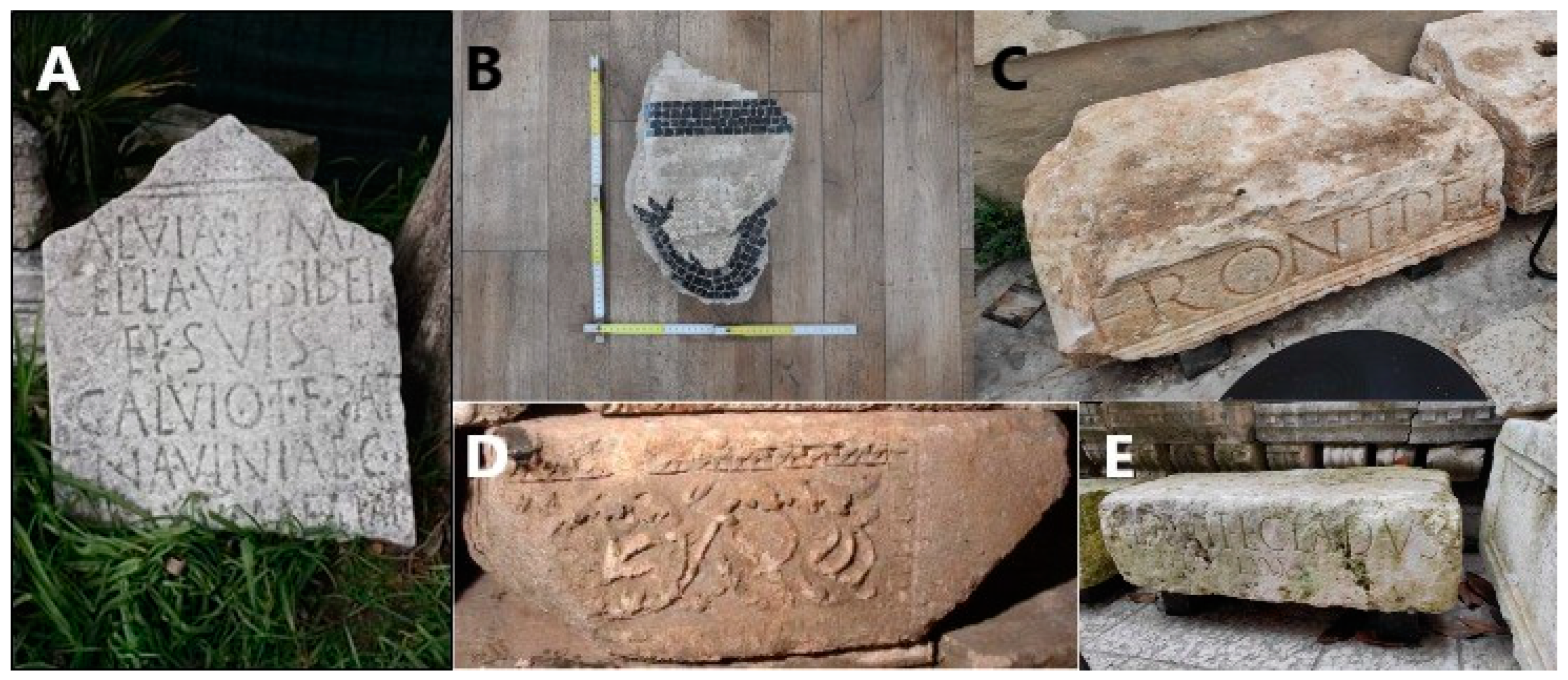

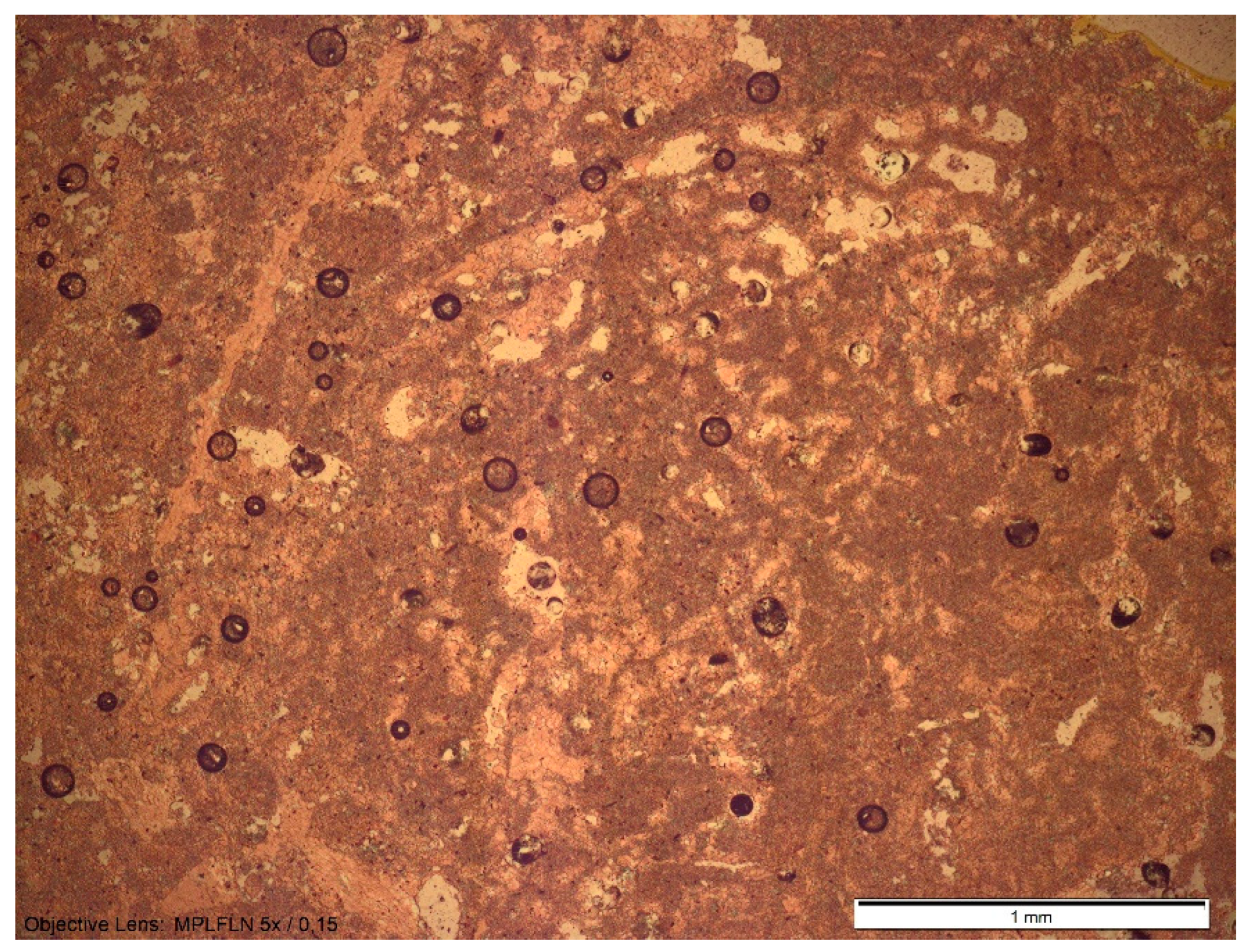
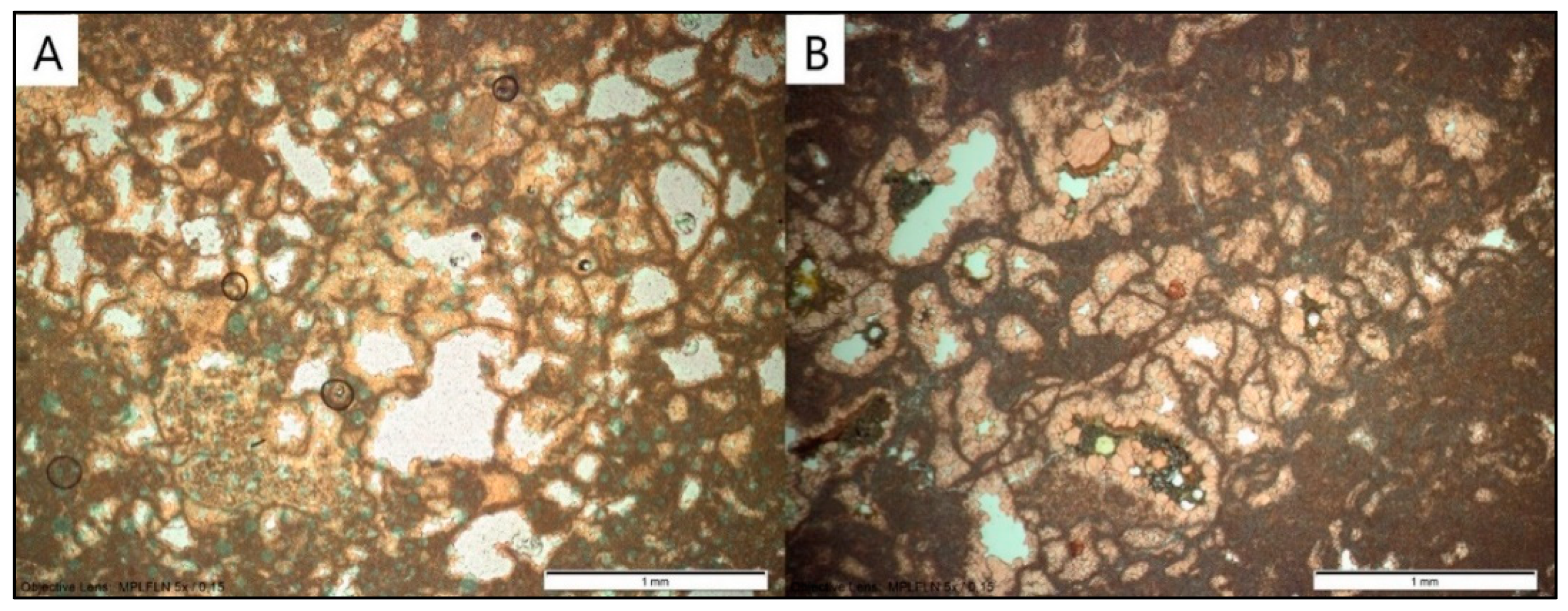
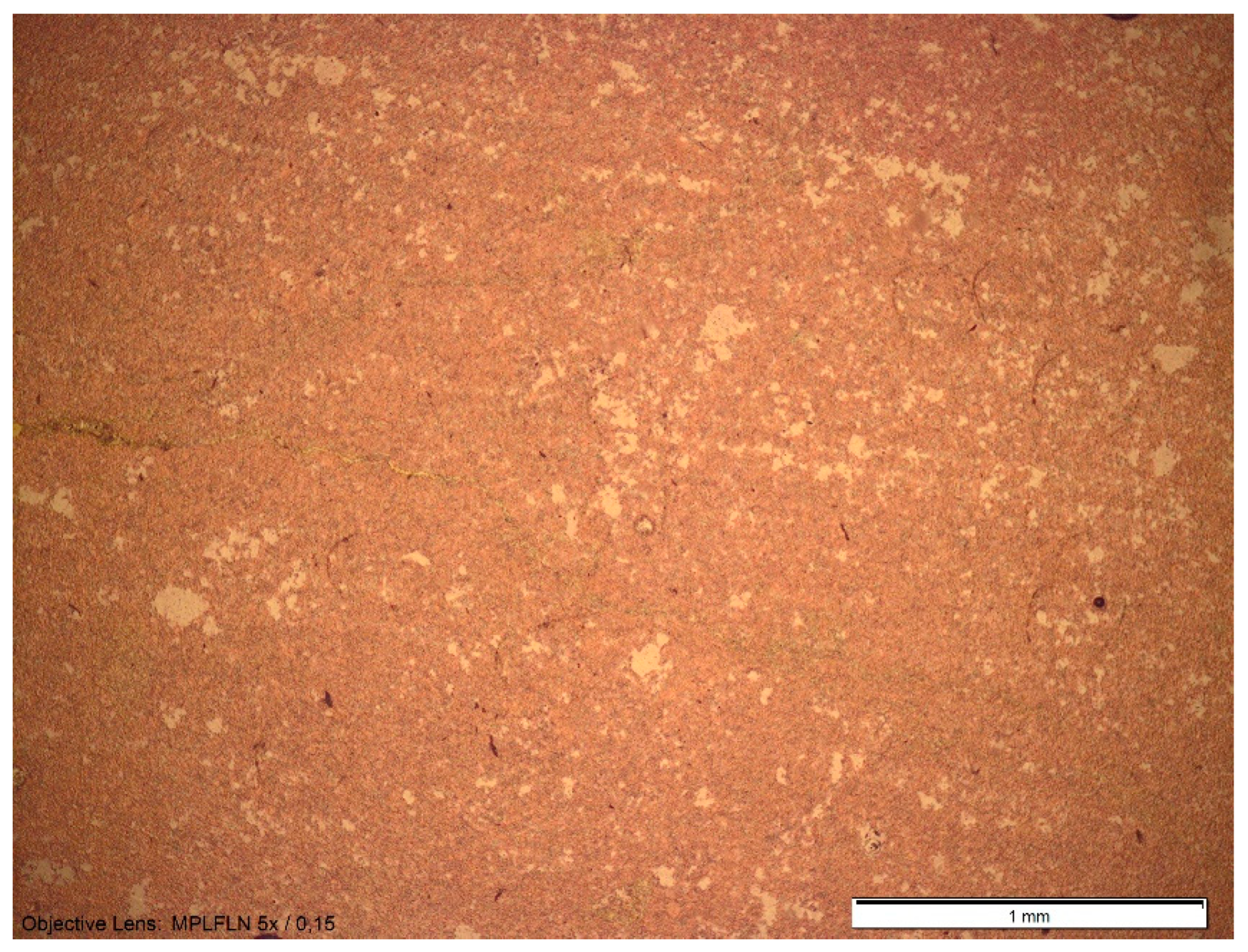
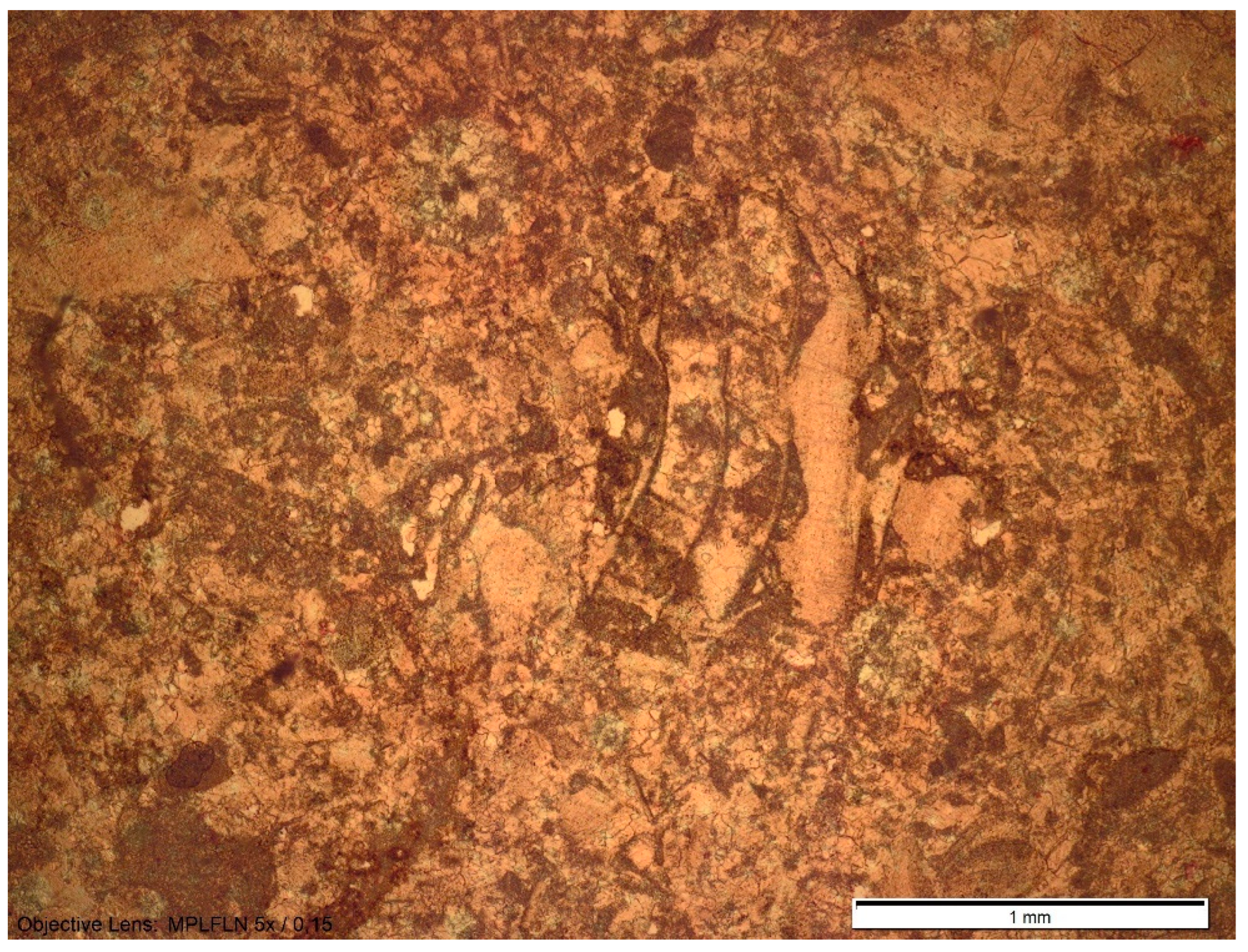

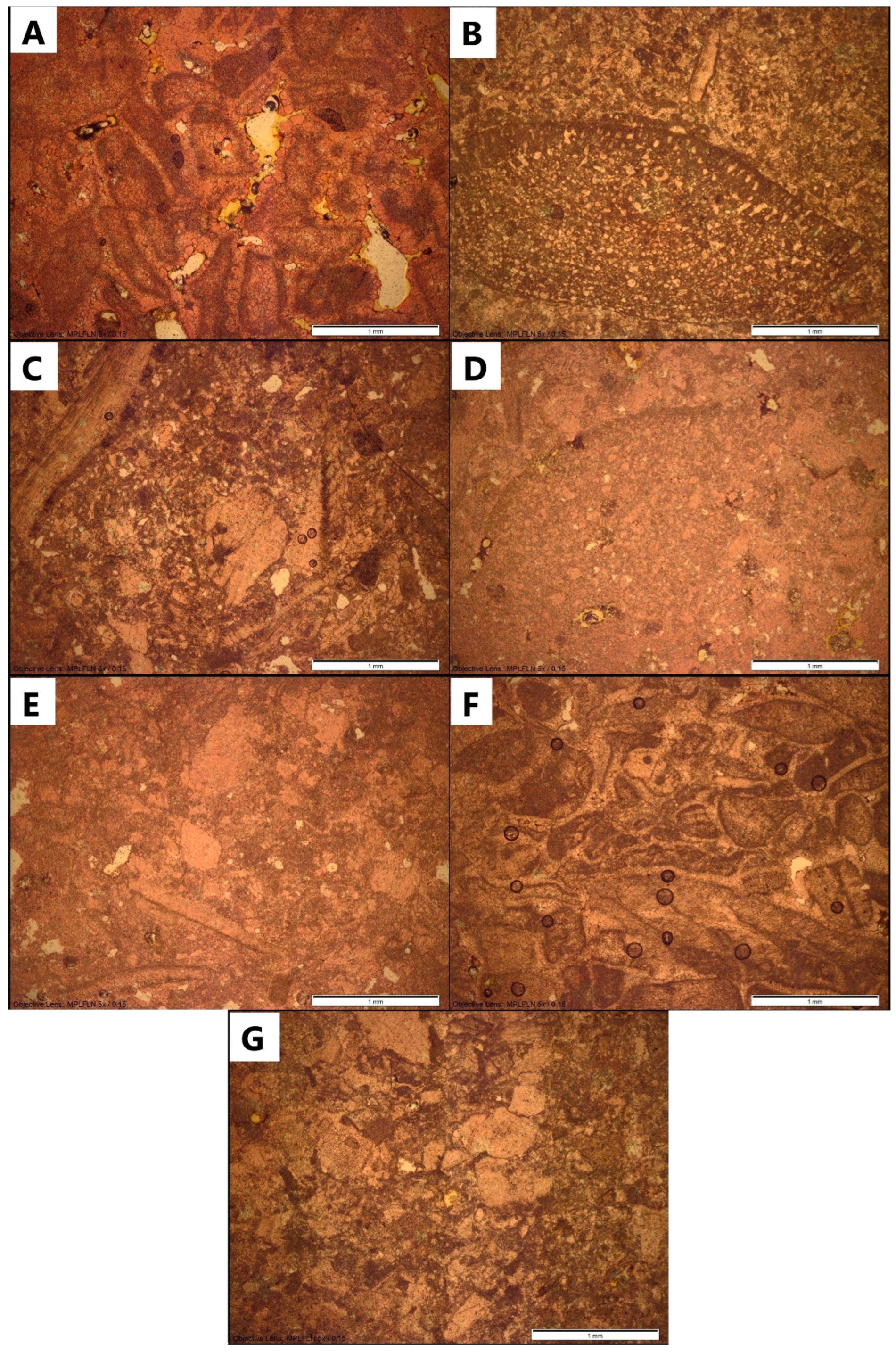
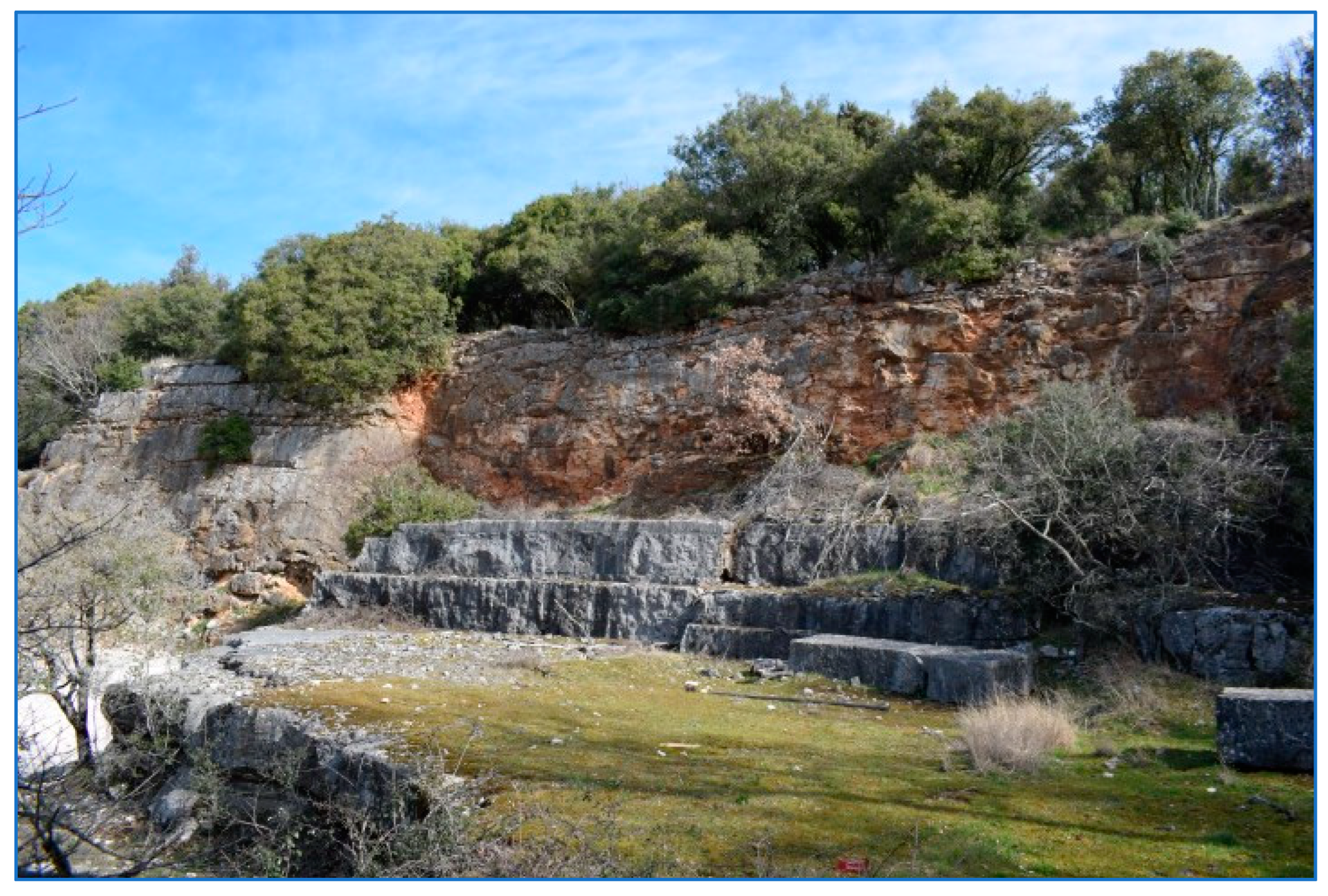



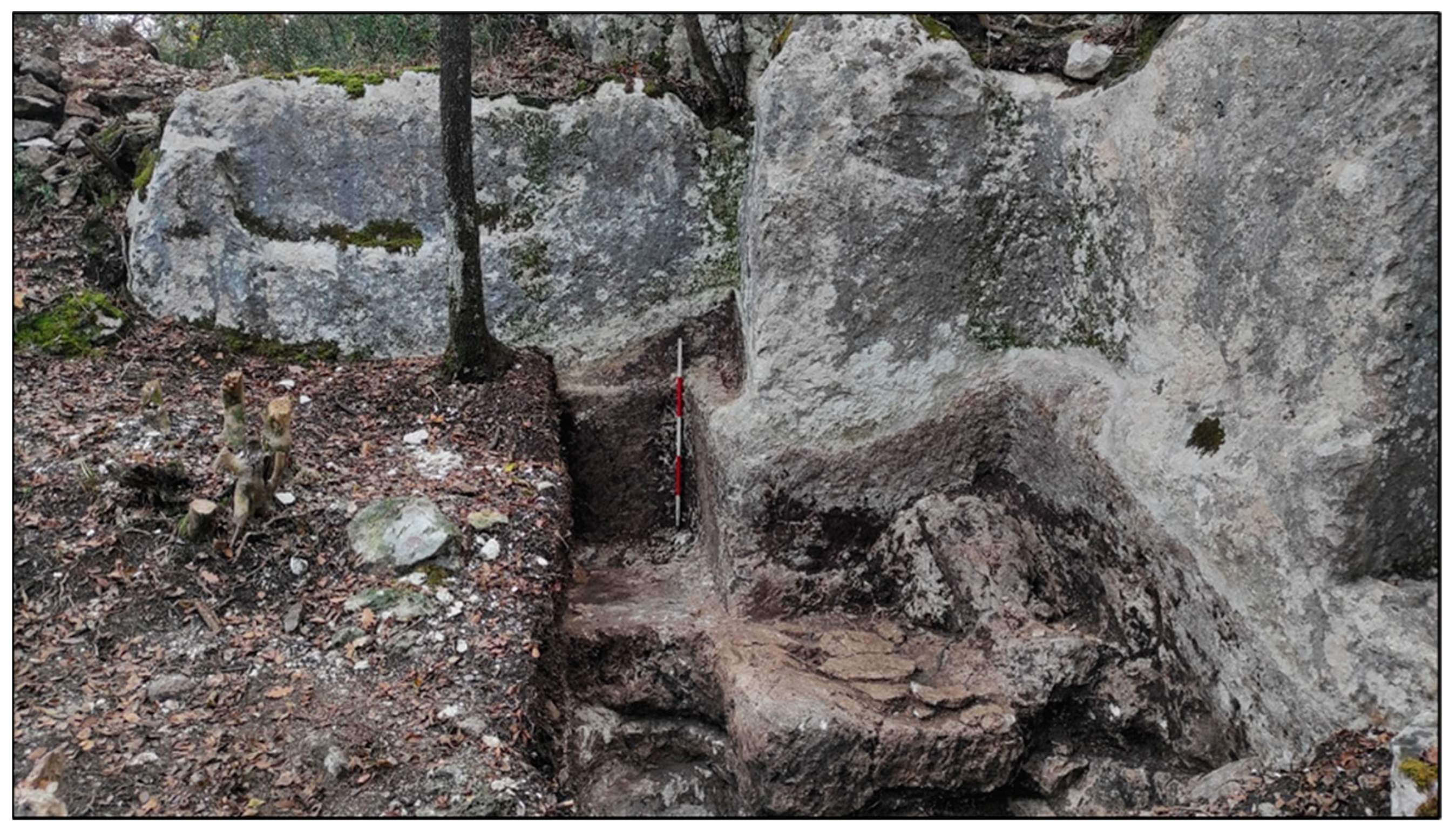
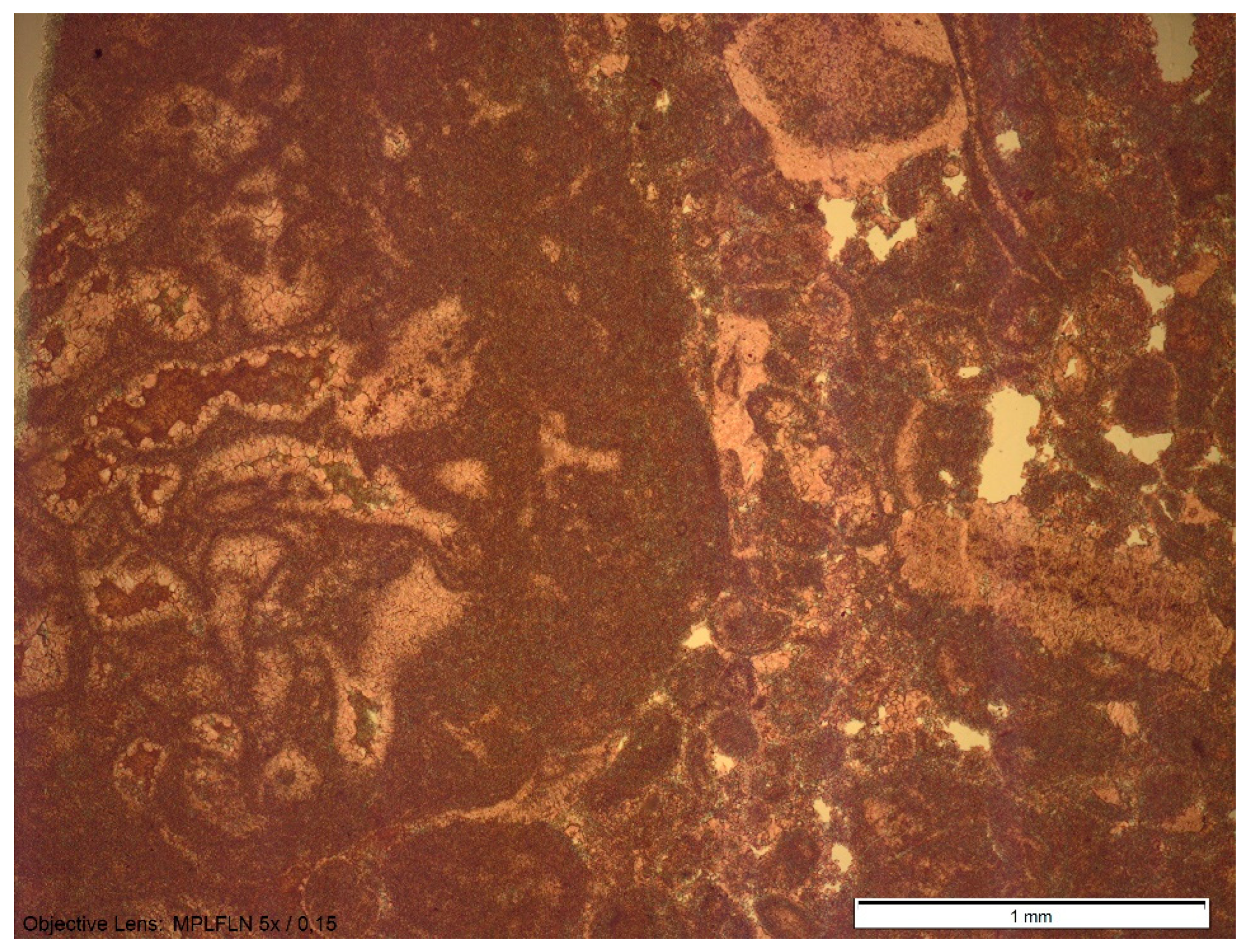





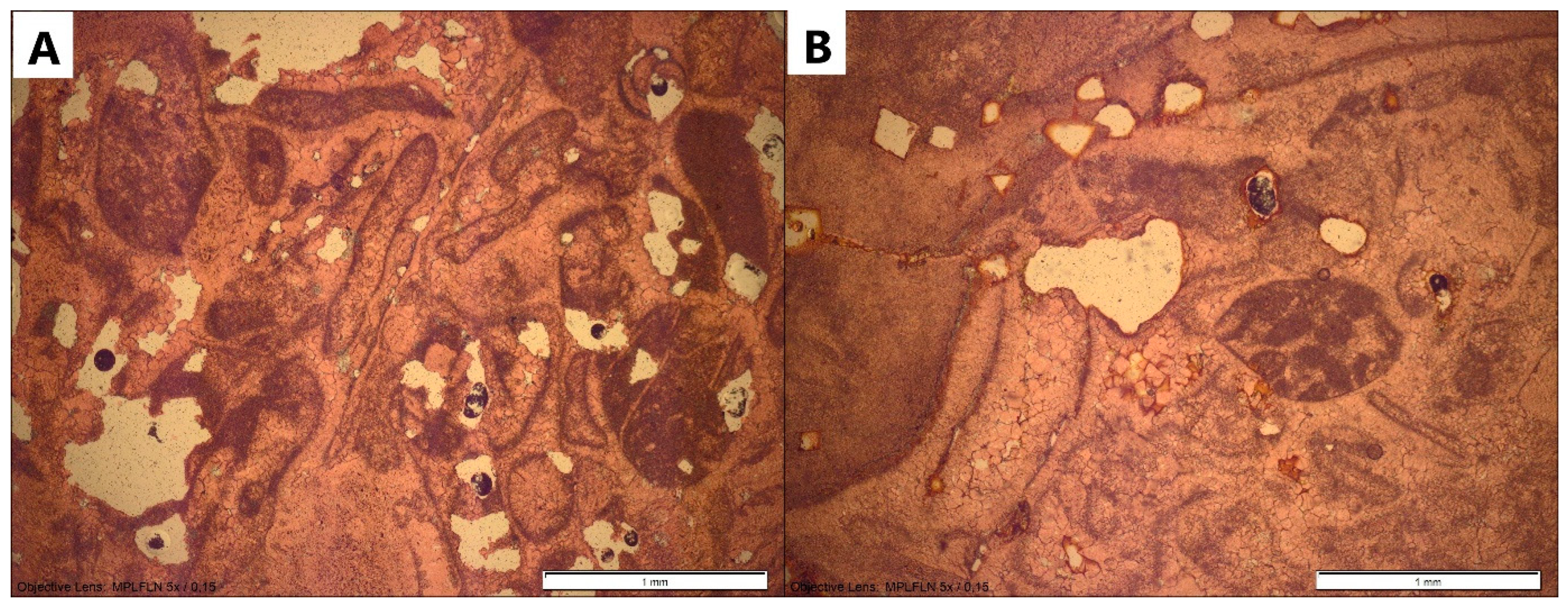


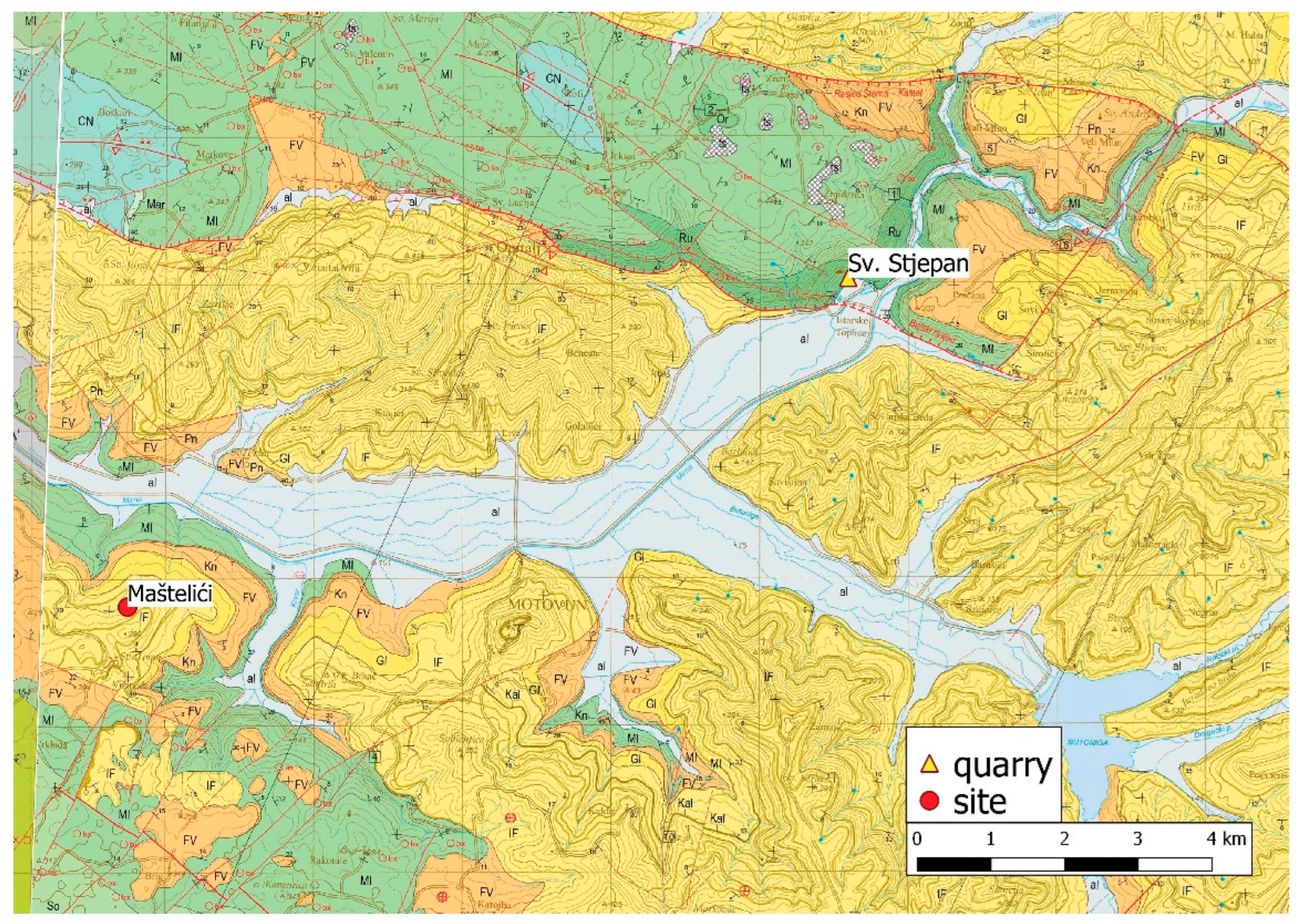
| Site | Ager | No of Sample | Type of Sample |
|---|---|---|---|
| Monte Ricco | Parentium | S-1 | white tessera |
| Parentium | S-2 | white tessera | |
| Parentium | S-3 | black tessera | |
| Parentium | S-4 | black tessera | |
| Poreč | Parentium | S-5 | stone beam |
| Parentium | S-6 | temple trabeation | |
| Parentium | S-7 | stone beam | |
| Maštelići | Parentium | S-8 | funerary monument |
| Pula | Pola | S-9 | sarcophagus lid |
| Pola | S-10 | cippus | |
| Pola | S-11 | funerary monument | |
| Pola | S-12 | funerary monument | |
| Pola | S-13 | funerary monument | |
| Pola | S-14 | architrave | |
| Pola | S-15 | funerary monument |
| Quarry | Ager | No of Sample | No on the Map |
|---|---|---|---|
| Monte Ricco | Parentium | Q-1 | 10 |
| Parentium | Q-2 | ||
| Poreč | Parentium | Q-5 | 5 |
| Biškupovi vrhi | Parentium | Q-6 | 11 |
| Pješčana Uvala | Pola | Q-7 | 37 |
| Pola | Q-8 | ||
| Cave Romane | Pola | Q-9 | 38 |
| Pola | Q-10 | ||
| Pola | Q-11 | ||
| Marčana | Pola | Q-12 | 30 |
| Pola | Q-13 |
Disclaimer/Publisher’s Note: The statements, opinions and data contained in all publications are solely those of the individual author(s) and contributor(s) and not of MDPI and/or the editor(s). MDPI and/or the editor(s) disclaim responsibility for any injury to people or property resulting from any ideas, methods, instructions or products referred to in the content. |
© 2024 by the author. Licensee MDPI, Basel, Switzerland. This article is an open access article distributed under the terms and conditions of the Creative Commons Attribution (CC BY) license (https://creativecommons.org/licenses/by/4.0/).
Share and Cite
Šprem, K. Micropetrography as a Key Preliminary Tool for Addressing Provenance Issues: Insights from a Roman Istria Case Study (Croatia). Minerals 2024, 14, 1233. https://doi.org/10.3390/min14121233
Šprem K. Micropetrography as a Key Preliminary Tool for Addressing Provenance Issues: Insights from a Roman Istria Case Study (Croatia). Minerals. 2024; 14(12):1233. https://doi.org/10.3390/min14121233
Chicago/Turabian StyleŠprem, Katarina. 2024. "Micropetrography as a Key Preliminary Tool for Addressing Provenance Issues: Insights from a Roman Istria Case Study (Croatia)" Minerals 14, no. 12: 1233. https://doi.org/10.3390/min14121233
APA StyleŠprem, K. (2024). Micropetrography as a Key Preliminary Tool for Addressing Provenance Issues: Insights from a Roman Istria Case Study (Croatia). Minerals, 14(12), 1233. https://doi.org/10.3390/min14121233








